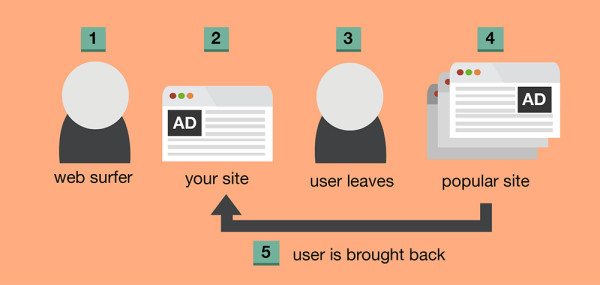Have you ever had that strange and frightening feeling that an ad follows and haunts you wherever you browse on the net? Sometimes you even see the same ad twice, thrice, and even 10 times a day on different sites. Aha, you have been caught by retargeting ads.
Whether you’re in B2B, e-Commerce or publishing, retargeting will almost always be beneficial for your business. Over the past months that I was testing retargeting for numerous clients, I saw how their campaigns grew significantly.
What is Retargeting?
Retargeting, also referred to as remarketing, is a type of online targeting advertising that keeps track of people who visit a website and follows them with banner ads as they visit other sites online. Officially, Google uses the term remarketing even though a large portion of the marketing community refers to retargeting for ads and remarketing for emails, so it’s a good idea to keep that in mind.
Statistics show that people who see retargeted ads are 70% more likely to convert. Talk about making more than one good impression to walk window-shoppers through the buyer’s journey. Retargeting is a great way to turn leads into potential customers!
How is it done? In a nutshell, you simply create tags, add them to your desired page, and then create custom combinations based on how you want them to perform. Trust me, it’s easier than it sounds.
When using retargeting, you can show relevant and timely messages tailored to all customers of the buying cycle based on which sections of your site they have visited. Combining retargeting efforts with other ad strategies you already do can help you sell 50% more products.
Whether it’s for direct response or branding, retargeting can be a strategic component of every campaign. It can drive return on investment (ROI) for all types of advertisers. It’s also a great way for advertisers to reach users who are likely to be highly receptive to their ads and special offers—bringing advertisers and websites higher returns.
Also Read: Retargeting vs Remarketing: Ultimate Guide
Still with me? Here’s a quick guide to retargeting to help you set up your first retargeting campaign:
Setting up your First Remarketing Campaign
-
Add your Google Ads Tag ID
To set up website retargeting, you’ll need to insert a code snippet to your site: the global site tag and the optional event snippet. The global site tag must be installed on all your web pages, while the event snippet can be utilized to track additional actions that must be counted as remarketing events. You can install the latter on certain pages you’d like to measure, such as when a customer makes a purchase on an e-commerce site.
This can be done through Shared Library>Audience sources of your Google Ads account.
-
Create Remarketing Lists
Create lists that you wish to target. For instance, visitors of your shampoo products, visitors of your conditioner products, abandoned carts, etc. You can also create All Visitors to your site, Visitors to a specific page or area of your site, Visitors who have completed a specific conversion goal etc.
You can do this in Google Analytics.
- To set it up, click the “admin” section of your account.
- Select “Audience definitions” and click “audiences.”
- Click the “New Audience” button.

- There will be an option to name your list. Choose an Analytics profile and Google Ads account for your list, then select the type of remarketing you want to run (i.e., all users/visitors or those that visit specific pages). You can also change the membership duration.
-
Upload Text/Banner Ads
It’s very important that you create tailored ads to the audience you are retargeting for. At this point, I’d assume that you’ve worked with your graphic designer in coming up with banner ads that will drive your target market to your site. As you upload your banners, keep in mind your individual categories, products, and services.
Get Started with Retargeting
Now that you know the steps of setting up your first retargeting campaign, make sure it aligns with your business goals and objectives.
I would say simple lists work well at first, but as your online advertising program grows, so will your retargeting strategies. You’ll begin to expand on what works better and will eventually venture into new areas to try out what works best and what doesn’t.
Need help with your online marketing campaigns? Learn more about our Paid Advertising services, or feel free to contact us if you have questions.










